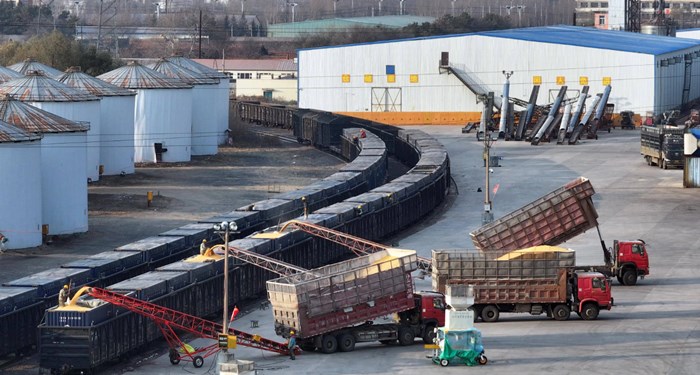On an autumn afternoon, the sea breeze from the Pearl River Estuary swept through the floor-to-ceiling windows of the sixth-floor conference room at Nansha Port, where a 100,000-ton bulk carrier was slowly berthing in the distance. On the large screen in the terminal's dispatch center, flashing data bars constantly jumped: an unloading efficiency of 4,000 tons per hour, an average port dwell time of 1.5 days, and real-time inventory of the silo complex with a storage capacity of 1.7 million tons—behind these figures lies the "lifeline" of Guangzhou's 18.8 million permanent residents consuming 7,500 tons of finished grain daily.
"A dozen years ago, this was just mudflats; now it's the largest grain transshipment hub in South China," said He Haining, General Manager of the Guangzhou Port Nansha Grain Terminal Branch, his voice filled with emotion. As a key node in the "North-to-South Grain Transport," Nansha Port now handles over 20 million tons of grain annually, with its bulk grain transshipment volume exceeding 10 million tons for four consecutive years. In the terminal's operating area, four dedicated grain silo loading lines, each capable of handling 2,000 tons per hour, are operating efficiently, reducing the time from unloading to storage by nearly half.
The accelerated pace of grain circulation stems from the digital upgrade of grain transportation and logistics, with the multimodal transport system equipping the north-to-south grain transport with a "smart brain."
On the 3,500-kilometer-long north-to-south grain transport route, grain first needs to be transported by rail to northern ports, then by sea to Guangzhou. Subsequently, some grain travels upstream along the Pearl River to inland river terminals; some is transported to the southwest via a bulk-to-container rail system; and some is directly delivered by road. This long chain poses a severe challenge to the traditional grain transportation and logistics system. Like a bustling old street, it inevitably encounters bottlenecks and disruptions in the face of ever-increasing transport volumes: multiple transshipments can easily lead to grain loss and deterioration; poor coordination between links can result in inefficiency and congestion; at the same time, transportation costs and seasonal concentrated transport pressures also pose challenges to the main artery of grain transport.
The solution lies in the breakthrough of the multimodal transport system. Multimodal transport is not simply a patchwork of transportation methods; rather, it's like conducting a symphony orchestra, allowing different "instruments" such as trains, ships, and automobiles to play in their most suitable movements, creating an optimal harmony of cost, efficiency, and environmental protection.
Especially under the "dual carbon" goal, the long-distance, low-carbon advantages of rail and water transport are becoming increasingly prominent. By reducing the repeated "transfers" of grain during transport, not only can losses be minimized, but logistics costs can also be reduced.
To address this, UGOOD has developed equipment such as a non-destructive multi-point grain unloading device and a self-cleaning low-damage hoist to solve the efficiency and loss problems in grain transportation.
Corn from Northeast China is first transported by rail to northern ports, then by sea to other ports. Subsequently, some is transported inland via the Pearl River waterway, while others are transferred by rail to the southwest, finally reaching the "last mile" of delivery by road. This process compresses the multiple transshipments in traditional transportation into three key nodes, reducing the logistics cost per ton of grain by 15% and controlling the loss rate to below 1.2%.
Furthermore, the multimodal transport system, through BIM technology and a digital twin system, has helped Nansha Port achieve full automation of bulk grain operations. This has increased production efficiency by 20% while also avoiding health risks for workers in high-temperature and dusty environments.
If Nansha Port is the "main artery" of "north-to-south grain transport," then the multi-story warehouses in Huangpu District, Guangzhou, are the "capillaries" of grain storage. At the state-owned grain depots in Huangpu District, Guangzhou, the "black technology" that solves the grain storage problem in southern regions—the circulating tubular chain conveyor—is also a crucial component of the "smart brain" for north-to-south grain transport.
"Single-story warehouses take up too much space, while multi-story warehouses face difficulties in unloading grain. The tubular chain conveyor system on the roof of the warehouse is dedicated to solving these problems," said Bai, chief engineer of UGOOD. The tubular chain conveyor system "flexibly shuttles" between floors, and its 10 unloading points reduce the amount of manual leveling, increasing unloading efficiency by 100% compared to traditional methods. Grain can flow into the tubular chain conveyor by itself, and then be loaded onto trucks in an environmentally friendly manner through a metering and dust suppression device.
As the sun sets, giant ships slowly depart from Nansha Port, while the chain conveyor belt at Huangpu Grain Depot continues its silent operation. Many industry insiders believe that ensuring efficient logistics for the north-to-south grain transport and food security relies not only on the throughput capacity of large ports, but also on the preservation capabilities of small grain depots, and, more importantly, on the collaborative efforts of the entire supply chain. These technological innovations, permeating the grain distribution chain, are using digital and intelligent services to safeguard the Chinese people's "rice bowl," making the north-to-south grain transport smoother and ensuring that every grain reaches the table safely and efficiently.
